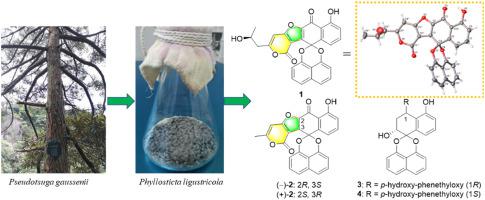Phytochemistry ( IF 3.8 ) Pub Date : 2023-04-25 , DOI: 10.1016/j.phytochem.2023.113687 Hao-Wei Chen 1 , Chun-Xiao Jiang 2 , Guang-Lei Ma 1 , Xi-Ying Wu 1 , Wei Jiang 1 , Jiyang Li 1 , Yi Zang 3 , Jia Li 3 , Juan Xiong 1 , Jin-Feng Hu 2

|
Four undescribed palmarumycin-type spirodioxynaphthalenes (phyligustricins A–D) and a known biogenetic precursor (palmarumycin BG1) were isolated from a solid fermentation of Phyllosticta ligustricola HDF-L-2, an endophyte associated with the endangered Chinese conifer Pseudotsuga gaussenii. The structures were elucidated by spectroscopic methods, single-crystal X-ray diffraction analyses, and electronic circular dichroism calculations. Both phyligustricins A and B have an unprecedented spirodioxynaphthalene-derived skeleton containing an extra 4H-furo [3,2-c]pyran-4-one moiety, while phyligustricins C and D are p-hydroxy-phenethyl substituted spirodioxynaphthalenes. The plausible biosynthetic relationships of the isolates were briefly proposed. Phyligustricins C and D and palmarumycin BG1 showed considerable antibacterial activity against Staphylococcus aureus, each with an MIC value of 16 μg/mL. Palmarumycin BG1 displayed significant inhibitory effects against ACL and ACC1, with IC50 values of 1.60 and 8.00 μM, respectively.



























 京公网安备 11010802027423号
京公网安备 11010802027423号